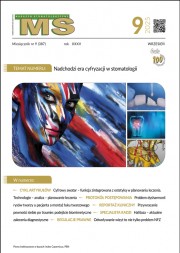Dostęp do tego artykułu jest płatny.
Zapraszamy do zakupu!
Po dokonaniu zakupu artykuł w postaci pliku PDF prześlemy bezpośrednio pod twój adres e-mail.
Streszczenie
W zakresie kompleksowego leczenia pacjentów z zaburzeniami okluzji czy stawów skroniowo-żuchwowych bardzo ważnym etapem jest odpowiednie zaplanowanie diagnostyki i leczenia. Duże znaczenie ma również poznanie współoddziaływań funkcjonalno-morfologicznych w obrębie głowy, szyi, jak również postawy całego ciała. Kluczowe w tym wypadku jest dodatkowo usystematyzowanie dotychczasowej wiedzy i oparcie procesu diagnostyczno-leczniczego na podstawie wiedzy stomatologicznej potwierdzonej naukowo (Evidence based dentistry – EBD).
Abstract
The key to successful treatment of patients with occlusion disorders or temporomandibular disorders is to completely understand functional and morphologic connections between head, neck and body posture. Proper diagnostics and our knowledge in this matter connected with EBD implicates appropriate treatment.
Hasła indeksowe: staw skroniowo-żuchwowy, postura ciała, okluzja, kręgosłup szyjny
Key words: temporomandibular joint, body posture, occlusion, cervical spine
PIŚMIENNICTWO
1. Makofsky H. The effect of head posture on muscle contact position: the sliding craniumtheory. Cranio. 1989; 7(4): 286-292.2.Rocabado M. Biomechanical relationship of the cranial, cervical, and hyoid regions. J Craniomandibular Pract. 1983; 1(3): 61-66.
3. Gelb H. Clinical Management of Head, Neck and TMJ Pain and Dysfunction. Philadelphia: WB Saunders Company;1977, s.73-177.
4. Guzay CM. Introduction to the quadrant theorem. Basal Facts. 1976; 1(4): 153-60.
5. Olmos SR i wsp. The effect of condyle fossa relationships on head posture. Cranio. 2005; 23(1): 48-52.
6. Solow B, Tallgren A. Head posture and craniofacial morphology. Am J Phys Anthropol. 1976; 44(3): 417-436.
7. Marcotte MR. Head posture and dentofacial proportions. Angle Orthod. 1981; 51(3): 208-213.
8. de Farias Neto JP i wsp. Radiographic measurement of the cervical spine in patients with temporomandibular dysfunction. Arch Oral Biol. 2010; 55(9): 670-678.
9. Uritani D i wsp. Characteristics of upper quadrant posture of young women with temporomandibular disorders. J Phys Ther Sci. 2014; 26(9): 1469-1472.
10. Flores HF, Ottone NE, Fuentes R. Analysis of the morphometric characteristics of the cervical spine and its association with the development of temporomandibular disorders. Cranio. 2017; 35(2): 79-85.
11. Chaves PJ, de Oliveira FEM, Damázio LCM. Incidence of postural changes and temporomandibular disorders in students. Acta Ortop Bras. 2017; 25(4): 162-164.
12. Matheus RA. The relationship between temporomandibular dysfunction and head and cervical posture. J Appl Oral Sci. 2009;17(3): 204-208.
13. Câmara-Souza MB i wsp. Cervical posture analysis in dental students and its correlation with temporomandibular disorder. Cranio. 2018; 36(2): 85-90.
14. Hanke BA, Motschall E, Türp JC. Association between orthopedic and dental findings: whatlevel of evidenceisavailable? J OrofacOrthop. 2007;68(2): 91-107.
15. Perinetti G, Contardo L. Posturography as a diagnostic aid in dentistry: a systematic review. J Oral Rehabil. 2009; 36(12): 922-936.
16. Manfredini D i wsp. Dental occlusion, body posture and temporomandibular disorders: where we are now and where we are heading for. J Oral Rehabil. 2012; 39(6): 463-471.
17. Chaves TC i wsp. Static body postural misalignment in individuals with temporomandibular disorders: a systematic review. Braz J Phys Ther. 2014; 18(6): 481-501.
18. La Touche R i wsp. The influence of cranio-cervical posture on maximal mouth opening and pressure pain threshold in patients with myofascial temporomandibular pain disorders. Clin J Pain. 2011; 27(1): 48-55.
19. La Touche R i wsp. The effects of manual therapy and exercise directed at the cervical spine on pain and pressure pain sensitivity in patients with myofascial temporomandibular disorders. J Oral Rehabil. 2009; 36(9): 644-652.
20. La Touche R i wsp. Does mobilization of the upper cervical spine affect pain sensitivity and autonomic nervous system function in patients with cervico-craniofacial pain?: A randomized-controlled trial. Clin J Pain. 2013; 29(3): 205-215.
21. Motta LJ i wsp. Craniocervical posture and bruxism in children. Physiother Res Int. 2011; 16(1): 57-61.
22. Restrepo CC i wsp. Effect of Physiotherapy on Bruxism and Head Posture.TMD/orofacial pain epidemiology and treatment –Seq #97 poster. IADR/AADR/CADR 85th General Session and Exhibition, March 22, 2007.
23.Okeson JP. Management of Temporomandibular Disorders and Occlusion. Part II: Etiology and identification of functional disturbances in the masticatory system. 7th ed. St. Louis: Mosby; 2013.
24. Manfredini D, Lombardo L, Siciliani G. Temporomandibular disorders and dental occlusion. A systematic review of association studies: end of an era? J Oral Rehabil. 2017; 44(11): 908-923.
25. Sakaguchi K i wsp. Examination of the relationship between mandibular position and body posture. Cranio. 2007; 25(4): 237-249.














